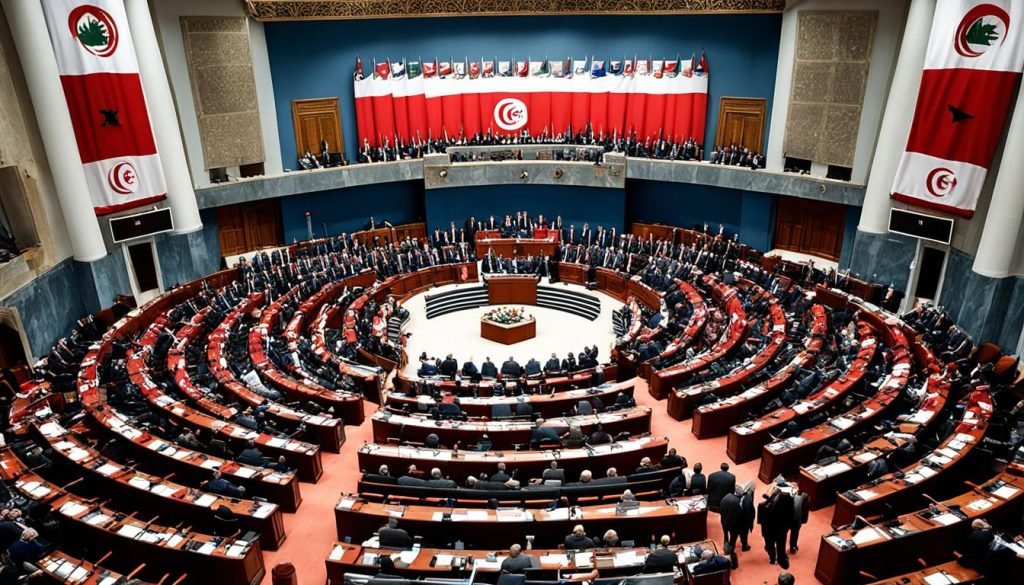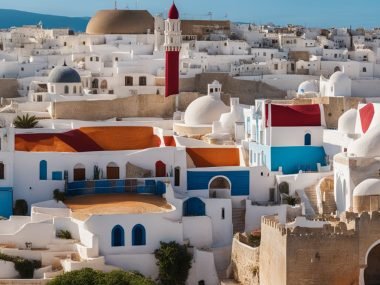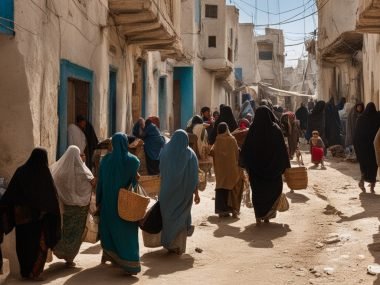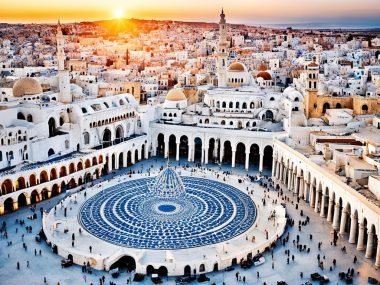Did you know Tunisia became a multi-party democracy recently? Before, it was mostly ruled by one party. This change happened in less than ten years. Now, it’s a vibrant democracy with new chances and some hurdles.
Tunisia is led by both a President and a Prime Minister. This setup is called a semi-presidential system. The country’s laws were inspired by France but have changed a lot. Today, Tunisia works well with many countries and groups like the Arab League and the African Union.
Key Takeaways
- Tunisia boasts a unitary semi-presidential representative democratic republic system.
- Tunisia underwent significant political transformation post the 2011 revolution.
- The President acts as the head of state, with the Prime Minister as the head of government.
- Tunisia’s legal system is influenced by French civil law.
- Strong international relations with the European Union, United States, and Africa.
Overview of Tunisian Political System
The Tunisian Political System has changed a lot over time. It moved from a one-party system to a broader democracy. Learning its history helps us understand it better today.
Historical Background
Tunisia gained independence in 1956. Back then, the president had a lot of power. President Habib Bourguiba and his party, Neo-Destour, led the country. But in the 1980s, they had to start changing things due to political pressure.
Even with these changes, the same party remained in charge until 2011. That year, a big uprising called the Jasmine Revolution happened. It changed the country into a democracy with many parties.
Post-2011 Revolution
After 2011, Tunisia went through big changes. It started allowing many political parties and set up checks and balances. The old ruling party was dissolved. The Ennahda party, which is moderately Islamist, became important in shaping the new democracy.
With the new rules, Tunisia balanced the power among its leaders better. They made a new constitution in 2014. This helped secure the country’s commitment to democracy.
Tunisia’s Constitution
Tunisia has changed a lot since it became independent. Each constitution has helped shape how the country is run. It shows how Tunisia tried to share out power, allow for many political voices, and protect freedoms.
The 1959 Constitution
In 1959, the President got most of the power. This made Tunisia have a system led by the president. The parliament wasn’t as important, showing a time of strong control. But, this was also when Tunisia started to build its political order and grow.
The 2014 Constitution
After a big change, Tunisia got a new constitution in 2014. This change made the parliament more powerful and balanced power better. It was a sign of hope. It supported many political voices, freedom of speech, and everybody being equal. This constitution is very important in Tunisia’s recent story. It strongly pushed the country towards democracy.
The 2022 Constitution
The 2022 Constitution, chosen by a vote, went back to giving the President more power. This changed how the country is run and reduced the power of parliament and the courts. It’s a bit controversial but shows that Tunisia is still trying to find the best way to govern. The country keeps aiming for fair government and progress, on its unique path.
The Executive Branch of Tunisia
Tunisia’s Executive Branch is quite complex. It leads the governance and law-making processes. It is key to the Tunisian Administration Setup.
The Role of the (President)
The President of Tunisia is a big deal. They lead the country and the military. As part of the Tunisian State Leadership, they pick the Prime Minister. They serve for five years.
The President handles foreign affairs and national safety. They can also suggest new laws. This greatly shapes Tunisia’s politics.
The Prime Minister and the Cabinet
The Prime Minister and their team manage the country day-to-day. They make sure the state’s rules are followed. Important roles are chosen by the state, while others, like mayors, are elected.
| Role | Responsibilities |
|---|---|
| President | Head of State, Commander in Chief, Foreign Policy, National Security |
| Prime Minister | Domestic Governance, Policy Implementation |
| Cabinet | Support in Policy Implementation |
| Regional Governors | Appointed by State |
| Mayors | Elected by Public Vote |
| Municipal Councils | Elected by Public Vote |
The Legislative Branch: Parliament
Tunisia’s legislative power is in the Assembly of the Representatives of the People. It shapes the country’s laws, guided by the Constitution. After 2011, a new constitution brought big changes, making politics more open.

Assembly of the Representatives of the People
The Assembly has 217 seats. It’s key in Tunisia’s law-making. It debates policies and makes laws based on the Constitution.
It aims to reflect true democracy. It’s a place for different political views. Various parties work together here, leading to better governance.
Tunisia had two legislative chambers before 2011. Now, it has one. This change made the legislative process stronger. It also gave more power to opposition parties.
National Council of Regions and Districts
The National Council of Regions and Districts advises the Assembly. It’s not for making laws. Instead, it represents local areas. It makes sure local issues get heard on a national level. It follows the Constitution’s rules and helps make better laws by offering insights.
It works closely with the Assembly. Together, they aim for well-balanced development across Tunisia. Their teamwork ensures laws consider every region’s needs and challenges.
| Assembly of the Representatives of the People | National Council of Regions and Districts |
|---|---|
| Unicameral legislative body with 217 seats | Advisory entity representing local regions |
| Engages in nationwide policy debates | Provides insights on regional issues |
| Strengthens the role of opposition parties | Enhances the inclusiveness of legislative decisions |
| Influences national governance and legislations | Fosters balanced developmental policies |
Judiciary System in Tunisia
The Judiciary System in Tunisia is key to how the country is run. It has its roots in French civil law. This gives a strong legal base that supports the Tunisia Governance Structure.
Structure and Functions
The judiciary includes many levels, like Courts of First Instance and Appellate Courts. There are also Administrative Courts and the top Court of Cassation. The Constitutional Court checks the laws against the constitution.
The Supreme Judicial Council looks after the judiciary. It makes sure everything runs smoothly within the Tunisia Governance Structure.
Independence of the Judiciary
The Judiciary System in Tunisia is known for being independent. This independence means that court decisions are fair and unbiased. It’s vital for keeping the trust of the public.
Such freedom helps to maintain a fair governance system. It also strengthens Tunisia’s democracy and legal integrity.
Administrative Divisions
To understand Tunisian Administrative Divisions, it’s key to grasp how local rule works. Tunisia has a mix of old and new systems for bettering government and local input. It has different levels of sectors for governance.
Governorates
Tunisia has 24 governorates as its main administrative pieces. Each is led by a governor managing the region. Governorates play a big role in applying national rules and helping local rule.
Delegations and Regional Councils
Below the governorates are delegations, much like districts elsewhere. This setup helps with closer management of tasks and services. Regional councils make sure things run smoothly and match both local and national needs.
Local Government
Local government in Tunisia aims at spreading power and increasing local say in rule. Mayors and councils are chosen by vote. They handle local matters and speak for the community. This government level is key as it boosts citizen involvement and makes services fit local needs.
The described Tunisian Administrative Divisions not only shape governance. They are also crucial in running elections, boosting democracy in Tunisia.
| Governorate | Number of Delegations | Local Government Offices |
|---|---|---|
| Tunis | 21 | Municipal Councils |
| Sfax | 16 | Mayor & Council |
| Ariana | 7 | Regional Councils |
| Gafsa | 11 | Local Mayors |
| Gabes | 13 | Municipal Councils |
Elections in Tunisia
The elections in Tunisia have really changed how democracy works there since 2011. We learn a lot by looking at these elections. They show us how the Tunisian Political System is changing.
Recent Presidential Elections
Kais Saied won the 2019 elections by a lot. His victory was a big win for democracy. It showed that people wanted new political leaders. Saied has been fighting corruption and making things more clear.
Recent Parliamentary Elections
The parliamentary elections also changed Tunisia’s politics. Ennahda became the biggest party then. But, with many different views in parliament, it shows Tunisia has a lot of diversity.
The 2022 referendum changed the Tunisian Political System a lot. It made the president’s role much stronger. These elections help us see how Tunisia’s politics keep changing.
Political Parties of Tunisia
Tunisia has seen big changes in its politics over years. Before 2011, one party was in charge. But now, there are many parties.

Historical Dominance of RCD
The RCD played a big part in Tunisia for a long time. They had strong roots and controlled the government. This time lacked variety in politics, with the RCD leading alone.
Post-2011 Multi-Party Landscape
The 2011 revolution was a huge turning point. With the RCD gone, many new parties came up. Groups like the Ennahda Movement started taking part. They brought in new ideas.
- Pre-Revolution
- RCD Controls Government
- Minimal Political Competition
- Emergence of New Parties
- Diverse Ideological Representation
Politics in Tunisia changed a lot after moving to a system with many parties. New parties play a big role now. They help decide the country’s direction.
What Is The Government Of Tunisia?
The Government of Tunisia has changed a lot after the Arab Spring. It’s on a path to full democracy. It has an elected president with big powers, a group that makes laws, and an independent judiciary. This keeps the law in check.
The country’s constitution sets the government’s structure. It balances state power and personal freedoms. This is key for fair governance. The Government of Tunisia combines old and new governance ways.
Here are the main parts of the Tunisia Governance Structure:
| Component | Description |
|---|---|
| Executive | The President and the Prime Minister form the executive branch, executing laws and managing the state’s day-to-day affairs. |
| Legislative | The Parliament, particularly the Assembly of the Representatives of the People, drafts and passes legislation essential for governance. |
| Judiciary | The judiciary is designed to be independent, ensuring the enforcement of laws and providing checks and balances on the executive and legislative branches. |
| Local Governance | Tunisia is divided into governorates, delegations, and local councils, each with dedicated administrative responsibilities to facilitate regional governance. |
The Tunisia Governance Structure keeps growing. This shows Tunisia’s commitment to democracy. Knowing about the Government of Tunisia lets us see the progress in democracy, despite obstacles.
Foreign Relations and Diplomacy
Tunisia’s government plays a big part in its global standing. It follows an active foreign policy. This approach has made Tunisia a strong player in world diplomacy. It has led to many partnerships and strategic alliances.
Key Diplomatic Missions
Tunisia works hard to keep up good relationships around the world. It is part of the African Union and the Arab League. So, it focuses on making strong connections with African and Arab countries. Tunisia also has many embassies worldwide. This helps it talk and work well with other nations.
Relationships with EU, USA, and Africa
Tunisia has important ties with the EU, USA, and African countries. The partnership with the EU is based on an Association Agreement. It boosts economic growth and stability in Tunisia. The country’s relationship with the USA supports security interests and provides economic help.
Tunisia also works a lot with African neighbours. This helps make North Africa more stable. Such work boosts Tunisia’s diplomatic efforts and its role in Africa.
| Region | Partner | Key Areas of Cooperation |
|---|---|---|
| European Union | EU | Economic, Social, Political |
| Americas | USA | Security, Economic Aid |
| Africa | Neighbouring States | Geopolitical Stability, Economic Cooperation |
Challenges Facing Tunisian Governance
Tunisia faces many hard obstacles. These include economic gaps and political fights. Together, they make governance and stability hard.
Economic Issues
Fixing Economic Issues in Tunisia is key for growth. The country has high jobless rates, inflation, and slow economic growth. This makes many people unhappy.
It’s vital to bring in economic changes. These changes should boost growth and lower unemployment. Many Tunisians now leave their country to find work elsewhere.
Political Instability
Political Instability in Tunisia deeply affects governance. The fight between secularists and Islamists adds to the trouble. So do frequent constitutional crises.
These issues weaken efforts to make democracy stronger. They make it hard to have stable governance.
The mix of Tunisian Administration Challenges shows a critical time of change. It’s crucial to tackle economic and political issues. A strong system and inclusive steps are needed for Tunisia’s bright future.
| Challenges | Implications | Potential Solutions |
|---|---|---|
| Economic Issues | High unemployment, inflation, emigration | Economic reforms, job creation, investment incentives |
| Political Instability | Internal divisions, constitutional crises | Political inclusiveness, strengthening institutions, dialogue |
Conclusion
Tunisia’s government story is a mix of dreams for democracy and big hurdles. Its semi-presidential system shows its hope for democracy, helping the country since it became independent. After the 2011 revolution, Tunisia worked hard to change its political, legislative, and judicial systems. They wanted these changes to reflect what its people want.
Looking closely at Tunisia’s governance shows a non-stop effort to make democracy stronger. This is despite political and economic ups and downs. The Tunisian Government keeps fighting to keep the freedoms they’ve worked hard for. They also protect the economic progress made over years. This journey of toughness and determination is still going on as new challenges come up.
Thinking about Tunisia’s current situation shows their governance plan is still being developed. It ties closely with what its people wish for. Their goal for democratic values and economic stability keeps guiding them. The future looks like it will bring more changes. Tunisia is committed to keeping and adding to its democratic principles.







